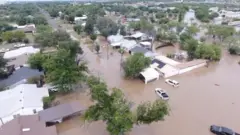Texas Flood Tragedy: Examining the Early Warnings and Preparedness in Kerr County
Texas Flood Tragedy: Examining the Early Warnings and Preparedness in Kerr County
Central Texas is grappling with the devastating aftermath of catastrophic flash floods that have claimed the lives of nearly 80 individuals, with the grim reality that this number is expected to rise as rescue operations continue. The heart-wrenching toll includes the lives of 28 children, many of whom were at a girls’ camp in Kerr County when the deluge struck.

Unforeseen Fury: Official Accounts of the Flood Event
Kerr County Judge Rob Kelly described the flooding as entirely unexpected, stating, “We had no reason to believe that this was gonna be any, anything like what’s happened here. None whatsoever.” This sentiment highlights the sheer scale and unprecedented nature of the disaster, leaving many questioning the adequacy of the warnings issued.
Timeline of Warnings: What Was Known and When?
The severe weather events began on Thursday night and persisted into Friday morning. Meteorologists have noted that the region experienced rainfall amounts typically seen over several months in a matter of hours. The Guadalupe River, a focal point of the disaster, saw its water levels surge by an astonishing 26 feet (8 meters) in just 45 minutes, breaching its banks and unleashing widespread devastation.
Key warnings and alerts were issued in the lead-up to the catastrophe:
- On Wednesday, the Texas Division of Emergency Management (TDEM) proactively activated state emergency response resources, recognizing the escalating threat of flooding in West and Central Texas.
- Thursday afternoon saw the National Weather Service (NWS) issue a Flood Watch, specifically identifying Kerr County as an area at high risk for overnight flash flooding.
- The first official Flash Flood Warning for Kerr County was issued at 01:14 local time (06:14 GMT) on Friday.
- Subsequently, an emergency flash flood warning was issued for Kerr County at 04:03 local time (09:30 GMT), followed by another specific warning for the Guadalupe River at 05:34.
Assessing Preparedness: The Debate Over Warning Systems
In the wake of the tragedy, Governor Greg Abbott commented on the public’s familiarity with flood warnings, suggesting that while Texans are accustomed to such alerts, the magnitude of this event—described as a “water wall of almost 30ft high”—was beyond typical expectations.
Nim Kidd, chief of the Texas Division of Emergency Management, pointed to challenges in communication, particularly in areas with limited or no cell phone coverage, implying that even robust alert systems might not reach everyone effectively.
Dalton Rice, Kerrville City Manager, reportedly mentioned that the public can become desensitized to frequent weather warnings. He recounted his personal experience of jogging along the Guadalupe River trail on Friday morning around 03:30, noting only light rain, only for the water to rise rapidly by 05:20, making escape from the park difficult.
Judge Kelly shed light on the absence of a county-administered warning system, citing cost as a prohibitive factor. He revealed that a proposal for a siren-like flood warning system, akin to tornado sirens, had been considered about six years prior but was never implemented due to financial constraints.
The National Weather Service (NWS) expressed its condolences for the tragic loss of life in Kerr County and defended its actions. The NWS stated that forecast briefings were provided to emergency management on July 3, with a Flood Watch issued later that afternoon. Crucially, Flash Flood Warnings were issued on the night of July 3 and early morning of July 4, providing “preliminary lead times of more than three hours before warning criteria were met.” Some experts have countered claims by Texas officials that the NWS underestimated the rainfall, with former NWS officials suggesting to The New York Times that the forecasts were as accurate as possible given the extreme and rapidly escalating rainfall event.
Concerns Over National Weather Service Staffing and Resources
The tragedy has also brought into focus concerns regarding potential impacts of budget cuts on the National Oceanic and Atmospheric Administration (NOAA), the parent agency of the NWS. Reports suggest that proposed budget cuts for Fiscal Year 2026 could affect weather research laboratories, and previous staffing reductions at NOAA and NWS have been noted. Meteorologists have voiced apprehension about a reported decrease in the number of weather balloons used for crucial atmospheric observations, potentially affecting forecasting accuracy.
The New York Times also raised questions about whether vacant critical positions within the NWS on the morning of the disaster might have hindered coordination with local emergency managers. However, conflicting information emerged, with Tom Fahy, legislative director of the NWS Employees Organization, asserting that weather forecasting offices had adequate staffing and resources. Furthermore, Jason Runyen, an NWS meteorologist, was quoted by the Associated Press stating that the specific office covering the affected central Texas area had five staff members on duty during the storms, exceeding the usual two.
Government Response and Future Preparedness
In response to questions about the government’s role in providing early warnings, US Homeland Security Secretary Kristi Noem acknowledged the inherent difficulty in predicting weather patterns but highlighted President Donald Trump’s commitment to modernizing the existing warning systems. She assured that concerns about the impact of NWS budget cuts would be relayed to the federal government, emphasizing that while the NWS has historically performed well, there is a shared desire for enhanced warning times through technological upgrades that have been long overdue.
Secretary Noem reiterated that improving prediction accuracy for rainfall amounts is a priority, and the Trump administration is focused on upgrading neglected technologies. She noted that President Trump’s administration is actively working on reforms and upgrading technology, a process that began upon his taking office.



Post Comment